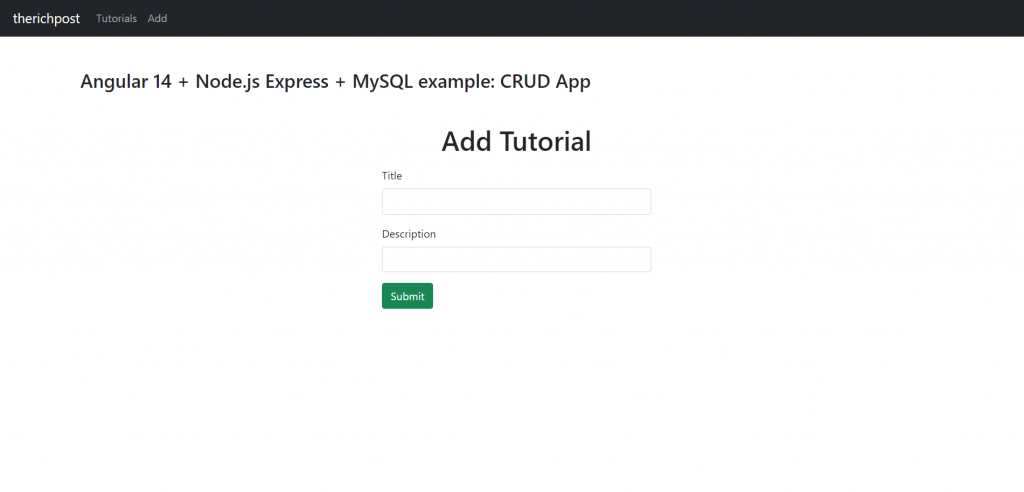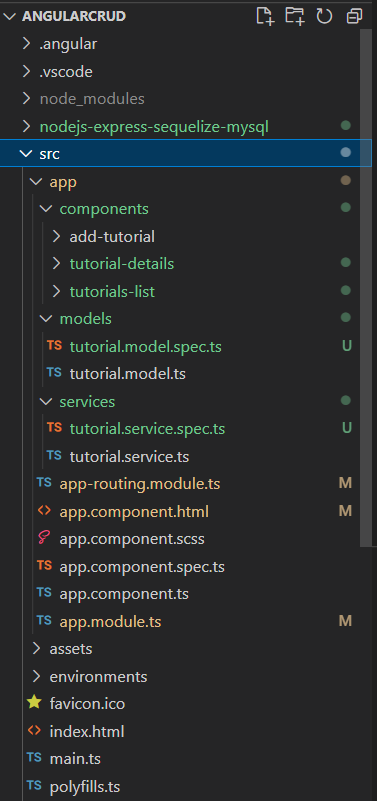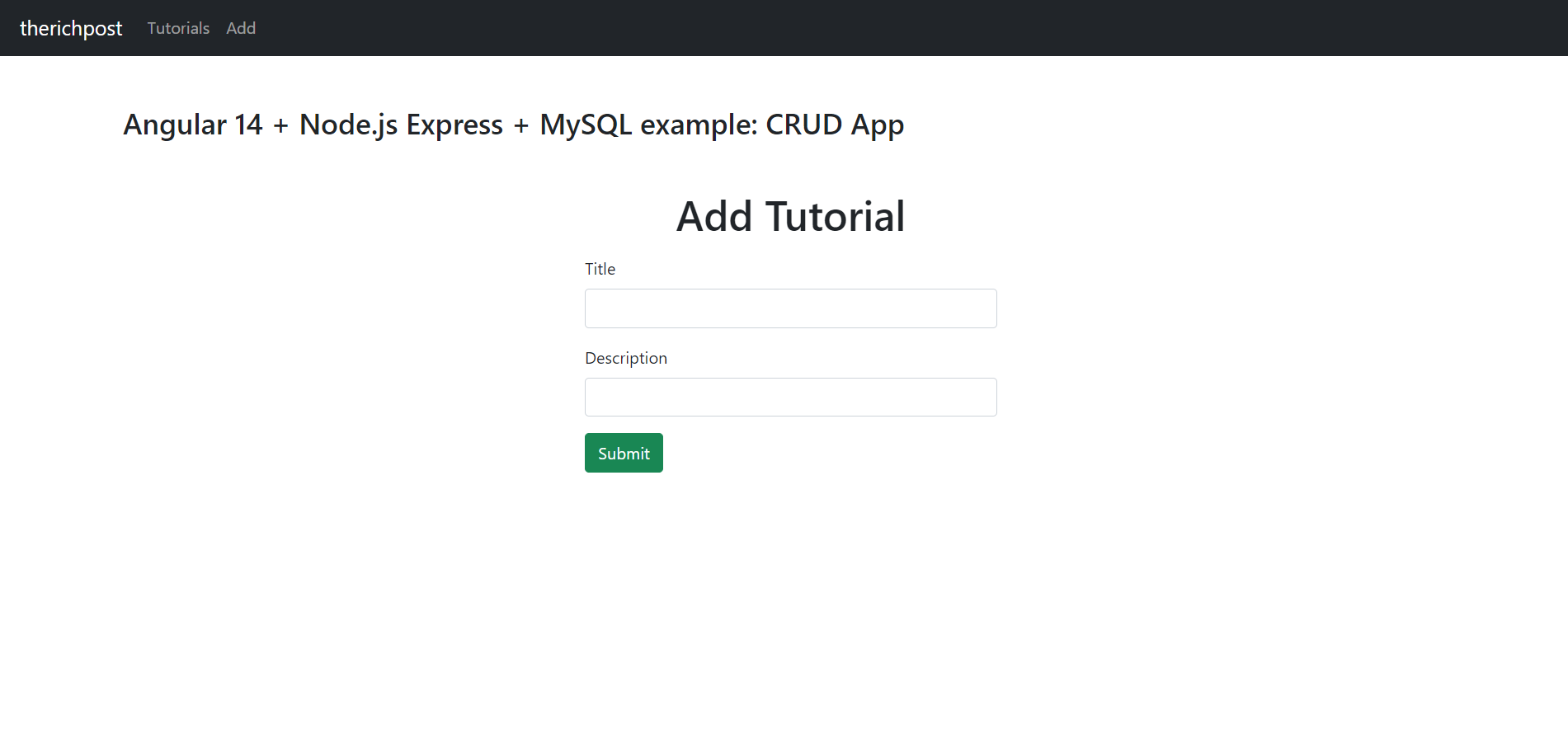Hello to all, welcome to therichpost.com. In this post, I will tell you, Angular 14 + Node.js Express + MySQL example: CRUD App.
Key features:
- Angular 14
- Bootstrap 5
- RxJs
- Nodejs
- Express
- Cors
- Mysql
- Add, update, delete, deleteAll, searchFilter
Angular 14 came and if you are new then please check below links:

Guys here is the working complete code snippet and please use carefully and if you have any kind of doubt then please comment below:
1. Very first, we need run below commands into our terminal to get angular 14 fresh setup:
npm install -g @angular/cli //Setup Angular14 atmosphere ng new angularcrud //Install New Angular App /**You need to update your Nodejs also for this verison**/ cd angularcrud //Go inside the Angular 14 Project
2. Now guys we need to run below commands into your terminal to get components, services, models and bootstrap 5 modules into your angular 14 application:
ng g class models/tutorial --type=model ng g c components/add-tutorial ng g c components/tutorial-details ng g c components/tutorials-list ng g s services/tutorial npm install bootstrap npm i @popperjs/core
After all above commands we will below image like folder structure:

3. Now add below code into your angular.json file for bootstrap styles:
"styles": [ ... "node_modules/bootstrap/dist/css/bootstrap.min.css", ], "scripts": [ ... "node_modules/bootstrap/dist/js/bootstrap.min.js", ]
4. Now add below code into your src/app/app.module.ts file:
...
import { FormsModule } from '@angular/forms';
import { HttpClientModule } from '@angular/common/http';
@NgModule({
declarations: [ ... ],
imports: [
...
FormsModule,
HttpClientModule
],
providers: [],
bootstrap: [AppComponent]
})
export class AppModule { }
5. Now add below code into your src/app/app-routing.module.ts file:
import { NgModule } from '@angular/core';
import { RouterModule, Routes } from '@angular/router';
import { TutorialsListComponent } from './components/tutorials-list/tutorials-list.component';
import { TutorialDetailsComponent } from './components/tutorial-details/tutorial-details.component';
import { AddTutorialComponent } from './components/add-tutorial/add-tutorial.component';
const routes: Routes = [
{ path: '', redirectTo: 'tutorials', pathMatch: 'full' },
{ path: 'tutorials', component: TutorialsListComponent },
{ path: 'tutorials/:id', component: TutorialDetailsComponent },
{ path: 'add', component: AddTutorialComponent }
];
@NgModule({
imports: [RouterModule.forRoot(routes)],
exports: [RouterModule]
})
export class AppRoutingModule { }
6. Now add below code into your src/app/app-component.html file:
<div>
<nav class="navbar navbar-expand navbar-dark bg-dark">
<a href="#" class="navbar-brand">therichpost</a>
<div class="navbar-nav mr-auto">
<li class="nav-item">
<a routerLink="tutorials" class="nav-link">Tutorials</a>
</li>
<li class="nav-item">
<a routerLink="add" class="nav-link">Add</a>
</li>
</div>
</nav>
<div class="container mt-5">
<router-outlet></router-outlet>
</div>
</div>
7. Now add below code into your src/app/models/tutorial.model.ts file for our four fields:
export class Tutorial {
id?: any;
title?: string;
description?: string;
published?: boolean;
}
8. Now add below code into your src/app/services/tutorial.service.ts file for api crud request:
import { Injectable } from '@angular/core';
import { HttpClient } from '@angular/common/http';
import { Observable } from 'rxjs';
import { Tutorial } from '../models/tutorial.model';
const baseUrl = 'http://localhost:8080/api/tutorials';
@Injectable({
providedIn: 'root'
})
export class TutorialService {
constructor(private http: HttpClient) { }
getAll(): Observable<Tutorial[]> {
return this.http.get<Tutorial[]>(baseUrl);
}
get(id: any): Observable<Tutorial> {
return this.http.get<Tutorial>(`${baseUrl}/${id}`);
}
create(data: any): Observable<any> {
return this.http.post(baseUrl, data);
}
update(id: any, data: any): Observable<any> {
return this.http.put(`${baseUrl}/${id}`, data);
}
delete(id: any): Observable<any> {
return this.http.delete(`${baseUrl}/${id}`);
}
deleteAll(): Observable<any> {
return this.http.delete(baseUrl);
}
findByTitle(title: any): Observable<Tutorial[]> {
return this.http.get<Tutorial[]>(`${baseUrl}?title=${title}`);
}
}
9. Now add below code into your src/app/components/add-tutorial/add-tutorial.component.ts file:
import { Component, OnInit } from '@angular/core';
import { Tutorial } from 'src/app/models/tutorial.model';
import { TutorialService } from 'src/app/services/tutorial.service';
@Component({
selector: 'app-add-tutorial',
templateUrl: './add-tutorial.component.html',
styleUrls: ['./add-tutorial.component.scss']
})
export class AddTutorialComponent implements OnInit {
tutorial: Tutorial = {
title: '',
description: '',
published: false
};
submitted = false;
constructor(private tutorialService: TutorialService) { }
ngOnInit(): void {
}
saveTutorial(): void {
const data = {
title: this.tutorial.title,
description: this.tutorial.description
};
this.tutorialService.create(data)
.subscribe({
next: (res) => {
console.log(res);
this.submitted = true;
},
error: (e) => console.error(e)
});
}
newTutorial(): void {
this.submitted = false;
this.tutorial = {
title: '',
description: '',
published: false
};
}
}
10. Now add below code into your src/app/components/add-tutorial/add-tutorial.component.html file:
<div class=" mt-5">
<h1 class="mb-3 text-center">Add Tutorial</h1>
<div class="submit-form">
<div *ngIf="!submitted">
<div class="form-group mb-3">
<label for="title" class="mb-2">Title</label>
<input
type="text"
class="form-control"
id="title"
required
[(ngModel)]="tutorial.title"
name="title"
/>
</div>
<div class="form-group mb-3">
<label for="description" class="mb-2">Description</label>
<input
class="form-control"
id="description"
required
[(ngModel)]="tutorial.description"
name="description"
/>
</div>
<button (click)="saveTutorial()" class="btn btn-success">Submit</button>
</div>
<div *ngIf="submitted">
<h4>Tutorial was submitted successfully!</h4>
<button class="btn btn-success" (click)="newTutorial()">Add</button>
</div>
</div>
</div>
11. Now add below code into your src/app/components/add-tutorial/add-tutorial.component.scss file:
.submit-form {
max-width: 400px;
margin: auto;
}
12. Now add below code into your src/app/components/tutorial-details/tutorial-details.component.ts file:
import { Component, Input, OnInit } from '@angular/core';
import { TutorialService } from 'src/app/services/tutorial.service';
import { ActivatedRoute, Router } from '@angular/router';
import { Tutorial } from 'src/app/models/tutorial.model';
@Component({
selector: 'app-tutorial-details',
templateUrl: './tutorial-details.component.html',
styleUrls: ['./tutorial-details.component.scss']
})
export class TutorialDetailsComponent implements OnInit {
@Input() viewMode = false;
@Input() currentTutorial: Tutorial = {
title: '',
description: '',
published: false
};
message = '';
constructor(
private tutorialService: TutorialService,
private route: ActivatedRoute,
private router: Router) { }
ngOnInit(): void {
if (!this.viewMode) {
this.message = '';
this.getTutorial(this.route.snapshot.params["id"]);
}
}
getTutorial(id: string): void {
this.tutorialService.get(id)
.subscribe({
next: (data) => {
this.currentTutorial = data;
console.log(data);
},
error: (e) => console.error(e)
});
}
updatePublished(status: boolean): void {
const data = {
title: this.currentTutorial.title,
description: this.currentTutorial.description,
published: status
};
this.message = '';
this.tutorialService.update(this.currentTutorial.id, data)
.subscribe({
next: (res) => {
console.log(res);
this.currentTutorial.published = status;
this.message = res.message ? res.message : 'The status was updated successfully!';
},
error: (e) => console.error(e)
});
}
updateTutorial(): void {
this.message = '';
this.tutorialService.update(this.currentTutorial.id, this.currentTutorial)
.subscribe({
next: (res) => {
console.log(res);
this.message = res.message ? res.message : 'This tutorial was updated successfully!';
},
error: (e) => console.error(e)
});
}
deleteTutorial(): void {
this.tutorialService.delete(this.currentTutorial.id)
.subscribe({
next: (res) => {
console.log(res);
this.router.navigate(['/tutorials']);
},
error: (e) => console.error(e)
});
}
}
13. Now add below code into your src/app/components/tutorial-details/tutorial-details.component.html file:
<div *ngIf="viewMode; else editable">
<div *ngIf="currentTutorial.id">
<h4>Tutorial</h4>
<div>
<label><strong>Title:</strong></label> {{ currentTutorial.title }}
</div>
<div>
<label><strong>Description:</strong></label>
{{ currentTutorial.description }}
</div>
<div>
<label><strong>Status:</strong></label>
{{ currentTutorial.published ? "Published" : "Pending" }}
</div>
<a
class="btn btn-warning"
routerLink="/tutorials/{{ currentTutorial.id }}"
>
Edit
</a>
</div>
<div *ngIf="!currentTutorial">
<br />
<p>Please click on a Tutorial...</p>
</div>
</div>
<ng-template #editable>
<div *ngIf="currentTutorial.id" class="edit-form">
<h4>Tutorial</h4>
<form>
<div class="form-group mb-3">
<label for="title" class="mb-2">Title</label>
<input
type="text"
class="form-control"
id="title"
[(ngModel)]="currentTutorial.title"
name="title"
/>
</div>
<div class="form-group mb-3">
<label for="description" class="mb-2">Description</label>
<input
type="text"
class="form-control"
id="description"
[(ngModel)]="currentTutorial.description"
name="description"
/>
</div>
<div class="form-group mb-5">
<label><strong>Status:</strong></label>
{{ currentTutorial.published ? "Published" : "Pending" }}
</div>
</form>
<button
class="btn btn-primary me-2 mb-2"
*ngIf="currentTutorial.published"
(click)="updatePublished(false)"
>
UnPublish
</button>
<button
*ngIf="!currentTutorial.published"
class="btn btn-primary me-2 mb-2"
(click)="updatePublished(true)"
>
Publish
</button>
<button class="btn btn-danger me-2 mb-2" (click)="deleteTutorial()">
Delete
</button>
<button
type="submit"
class="btn btn-success mb-2"
(click)="updateTutorial()"
>
Update
</button>
<p>{{ message }}</p>
</div>
<div *ngIf="!currentTutorial.id">
<br />
<p>Cannot access this Tutorial...</p>
</div>
</ng-template>
14. Now add below code into your src/app/components/tutorial-details/tutorial-details.component.scss file:
.list {
text-align: left;
max-width: 750px;
margin: auto;
}
.edit-form {
max-width: 400px;
margin: auto;
}
15. Now add below code into your src/app/components/tutorials-list/tutorials-list.component.ts file:
import { Component, OnInit } from '@angular/core';
import { Tutorial } from 'src/app/models/tutorial.model';
import { TutorialService } from 'src/app/services/tutorial.service';
@Component({
selector: 'app-tutorials-list',
templateUrl: './tutorials-list.component.html',
styleUrls: ['./tutorials-list.component.scss']
})
export class TutorialsListComponent implements OnInit {
tutorials?: Tutorial[];
currentTutorial: Tutorial = {};
currentIndex = -1;
title = '';
constructor(private tutorialService: TutorialService) { }
ngOnInit(): void {
this.retrieveTutorials();
}
retrieveTutorials(): void {
this.tutorialService.getAll()
.subscribe({
next: (data) => {
this.tutorials = data;
console.log(data);
},
error: (e) => console.error(e)
});
}
refreshList(): void {
this.retrieveTutorials();
this.currentTutorial = {};
this.currentIndex = -1;
}
setActiveTutorial(tutorial: Tutorial, index: number): void {
this.currentTutorial = tutorial;
this.currentIndex = index;
}
removeAllTutorials(): void {
this.tutorialService.deleteAll()
.subscribe({
next: (res) => {
console.log(res);
this.refreshList();
},
error: (e) => console.error(e)
});
}
searchTitle(): void {
this.currentTutorial = {};
this.currentIndex = -1;
this.tutorialService.findByTitle(this.title)
.subscribe({
next: (data) => {
this.tutorials = data;
console.log(data);
},
error: (e) => console.error(e)
});
}
}
16. Now add below code into your src/app/components/tutorials-list/tutorials-list.component.html file:
<div class="list row mt-5">
<div class="col-md-8">
<div class="input-group mb-3">
<input
type="text"
class="form-control"
placeholder="Search by title"
[(ngModel)]="title"
/>
<div class="input-group-append">
<button
class="btn btn-outline-secondary"
type="button"
(click)="searchTitle()"
>
Search
</button>
</div>
</div>
</div>
<div class="col-md-6 mt-3">
<h4 class="mb-3">Tutorials List</h4>
<ul class="list-group mb-3">
<li
class="list-group-item"
*ngFor="let tutorial of tutorials; let i = index"
[class.active]="i == currentIndex"
(click)="setActiveTutorial(tutorial, i)"
>
{{ tutorial.title }}
</li>
</ul>
<button class="btn btn-sm btn-danger" (click)="removeAllTutorials()">
Remove All
</button>
</div>
<div class="col-md-6">
<app-tutorial-details
[viewMode]="true"
[currentTutorial]="currentTutorial"
></app-tutorial-details>
</div>
</div>
Guys now we have all the angular code and below I am going to write nodejs+express code and please follow it carefully also:
1. Now guys create folder `nodejs-express-sequelize-mysql` inside angular project root and run below command inside the folder:
npm init name: (nodejs-express-sequelize-mysql) version: (1.0.0) description: Node.js Rest Apis with Express, Sequelize & MySQL. entry point: (index.js) server.js test command: git repository: keywords: nodejs, express, sequelize, mysql, rest, api author: therichpost license: (ISC) Is this ok? (yes) yes
2. Guys now inside `nodejs-express-sequelize-mysql` folder create server.js file and add below code inside it:
const express = require("express");
const cors = require("cors");
const app = express();
var corsOptions = {
origin: "http://localhost:4200"
};
app.use(cors(corsOptions));
// parse requests of content-type - application/json
app.use(express.json());
// parse requests of content-type - application/x-www-form-urlencoded
app.use(express.urlencoded({ extended: true }));
const db = require("./app/models");
db.sequelize.sync()
.then(() => {
console.log("Synced db.");
})
.catch((err) => {
console.log("Failed to sync db: " + err.message);
});
// simple route
app.get("/", (req, res) => {
res.json({ message: "Welcome to therichpost application." });
});
// set port, listen for requests
require("./app/routes/turorial.routes")(app);
const PORT = process.env.PORT || 8080;
app.listen(PORT, () => {
console.log(`Server is running on port ${PORT}.`);
});
3. Guys also run below command inside `nodejs-express-sequelize-mysql` folder:
npm install express sequelize mysql2 cors --save
4. Now guys create `app` folder inside `nodejs-express-sequelize-mysql` folder.
5. Now guys create `config` folder inside `nodejs-express-sequelize-mysql/app` folder and then create `db.config.js` file inside nodejs-express-sequelize-mysql/app/config and add below code inside it for mysql connection:
module.exports = {
HOST: "localhost",
USER: "root",
PASSWORD: "",
DB: "testdb",
dialect: "mysql",
pool: {
max: 5,
min: 0,
acquire: 30000,
idle: 10000
}
};
6. Now guys create `controllers` folder inside `nodejs-express-sequelize-mysql/app` folder and then create `tutorial.controller.js` file inside nodejs-express-sequelize-mysql/app/controllers and add below code inside it for crud functions:
const db = require("../models");
const Tutorial = db.tutorials;
const Op = db.Sequelize.Op;
// Create and Save a new Tutorial
exports.create = (req, res) => {
// Validate request
if (!req.body.title) {
res.status(400).send({
message: "Content can not be empty!"
});
return;
}
// Create a Tutorial
const tutorial = {
title: req.body.title,
description: req.body.description,
published: req.body.published ? req.body.published : false
};
// Save Tutorial in the database
Tutorial.create(tutorial)
.then(data => {
res.send(data);
})
.catch(err => {
res.status(500).send({
message:
err.message || "Some error occurred while creating the Tutorial."
});
});
};
// Retrieve all Tutorials from the database.
exports.findAll = (req, res) => {
const title = req.query.title;
var condition = title ? { title: { [Op.like]: `%${title}%` } } : null;
Tutorial.findAll({ where: condition })
.then(data => {
res.send(data);
})
.catch(err => {
res.status(500).send({
message:
err.message || "Some error occurred while retrieving tutorials."
});
});
};
// Find a single Tutorial with an id
exports.findOne = (req, res) => {
const id = req.params.id;
Tutorial.findByPk(id)
.then(data => {
if (data) {
res.send(data);
} else {
res.status(404).send({
message: `Cannot find Tutorial with id=${id}.`
});
}
})
.catch(err => {
res.status(500).send({
message: "Error retrieving Tutorial with id=" + id
});
});
};
// Update a Tutorial by the id in the request
exports.update = (req, res) => {
const id = req.params.id;
Tutorial.update(req.body, {
where: { id: id }
})
.then(num => {
if (num == 1) {
res.send({
message: "Tutorial was updated successfully."
});
} else {
res.send({
message: `Cannot update Tutorial with id=${id}. Maybe Tutorial was not found or req.body is empty!`
});
}
})
.catch(err => {
res.status(500).send({
message: "Error updating Tutorial with id=" + id
});
});
};
// Delete a Tutorial with the specified id in the request
exports.delete = (req, res) => {
const id = req.params.id;
Tutorial.destroy({
where: { id: id }
})
.then(num => {
if (num == 1) {
res.send({
message: "Tutorial was deleted successfully!"
});
} else {
res.send({
message: `Cannot delete Tutorial with id=${id}. Maybe Tutorial was not found!`
});
}
})
.catch(err => {
res.status(500).send({
message: "Could not delete Tutorial with id=" + id
});
});
};
// Delete all Tutorials from the database.
exports.deleteAll = (req, res) => {
Tutorial.destroy({
where: {},
truncate: false
})
.then(nums => {
res.send({ message: `${nums} Tutorials were deleted successfully!` });
})
.catch(err => {
res.status(500).send({
message:
err.message || "Some error occurred while removing all tutorials."
});
});
};
// Find all published Tutorials
exports.findAllPublished = (req, res) => {
Tutorial.findAll({ where: { published: true } })
.then(data => {
res.send(data);
})
.catch(err => {
res.status(500).send({
message:
err.message || "Some error occurred while retrieving tutorials."
});
});
};
7. Now guys create `routes` folder inside `nodejs-express-sequelize-mysql/app` folder and then create `turorial.routes.js` file inside nodejs-express-sequelize-mysql/app/routes and add below code inside it for api routing:
module.exports = app => {
const tutorials = require("../controllers/tutorial.controller.js");
var router = require("express").Router();
// Create a new Tutorial
router.post("/", tutorials.create);
// Retrieve all Tutorials
router.get("/", tutorials.findAll);
// Retrieve all published Tutorials
router.get("/published", tutorials.findAllPublished);
// Retrieve a single Tutorial with id
router.get("/:id", tutorials.findOne);
// Update a Tutorial with id
router.put("/:id", tutorials.update);
// Delete a Tutorial with id
router.delete("/:id", tutorials.delete);
// Delete all Tutorials
router.delete("/", tutorials.deleteAll);
app.use('/api/tutorials', router);
};
8. Now guys create `models` folder inside `nodejs-express-sequelize-mysql/app` folder and then create `index.js` file inside nodejs-express-sequelize-mysql/app/models and add below code inside it for models:
const dbConfig = require("../config/db.config.js");
const Sequelize = require("sequelize");
const sequelize = new Sequelize(dbConfig.DB, dbConfig.USER, dbConfig.PASSWORD, {
host: dbConfig.HOST,
dialect: dbConfig.dialect,
operatorsAliases: false,
pool: {
max: dbConfig.pool.max,
min: dbConfig.pool.min,
acquire: dbConfig.pool.acquire,
idle: dbConfig.pool.idle
}
});
const db = {};
db.Sequelize = Sequelize;
db.sequelize = sequelize;
db.tutorials = require("./tutorial.model.js")(sequelize, Sequelize);
module.exports = db;
9. Now guys create `models` folder inside `nodejs-express-sequelize-mysql/app` folder and then create `tutorial.model.js` file inside nodejs-express-sequelize-mysql/app/models and add below code inside it for models
(This Sequelize Model represents tutorials table in MySQL database. These columns will be generated automatically: id, title, description, published, createdAt, updatedAt.):
module.exports = (sequelize, Sequelize) => {
const Tutorial = sequelize.define("tutorial", {
title: {
type: Sequelize.STRING
},
description: {
type: Sequelize.STRING
},
published: {
type: Sequelize.BOOLEAN
}
});
return Tutorial;
};
Guys in the end for angular 14 please run ng serve command and nodejs please run node server.js command.
Jassa
Thanks

Node server.js is not working. kindly explain more in node js side or MySQL
Okay sure and here is demo with MySQL:
https://therichpost.com/angular-11-crud-add-edit-delete-tutorial/